App Marketplace
The App Marketplace is the venue for publishing applications created in the application creation process. It consists of two sections: My Space and Public Space. My Space is a personal workspace that stores personal applications or applications authorized for viewing by others. Public Space is where team applications are published, serving as the enterprise's external-facing window in a hierarchical structure.
Users with the "Data Analysis" or "Data Viewing" roles can view their own published applications as well as applications published to them by other users in the App Marketplace.
Public Space
The public space displays applications in a hierarchical structure, allowing users with corresponding permissions to view the relevant content. The public space requires dedicated management, specifically by a public space administrator. Administrators can manage and authorize applications belonging to the same business domain, sharing them with team members or tenant users for viewing.
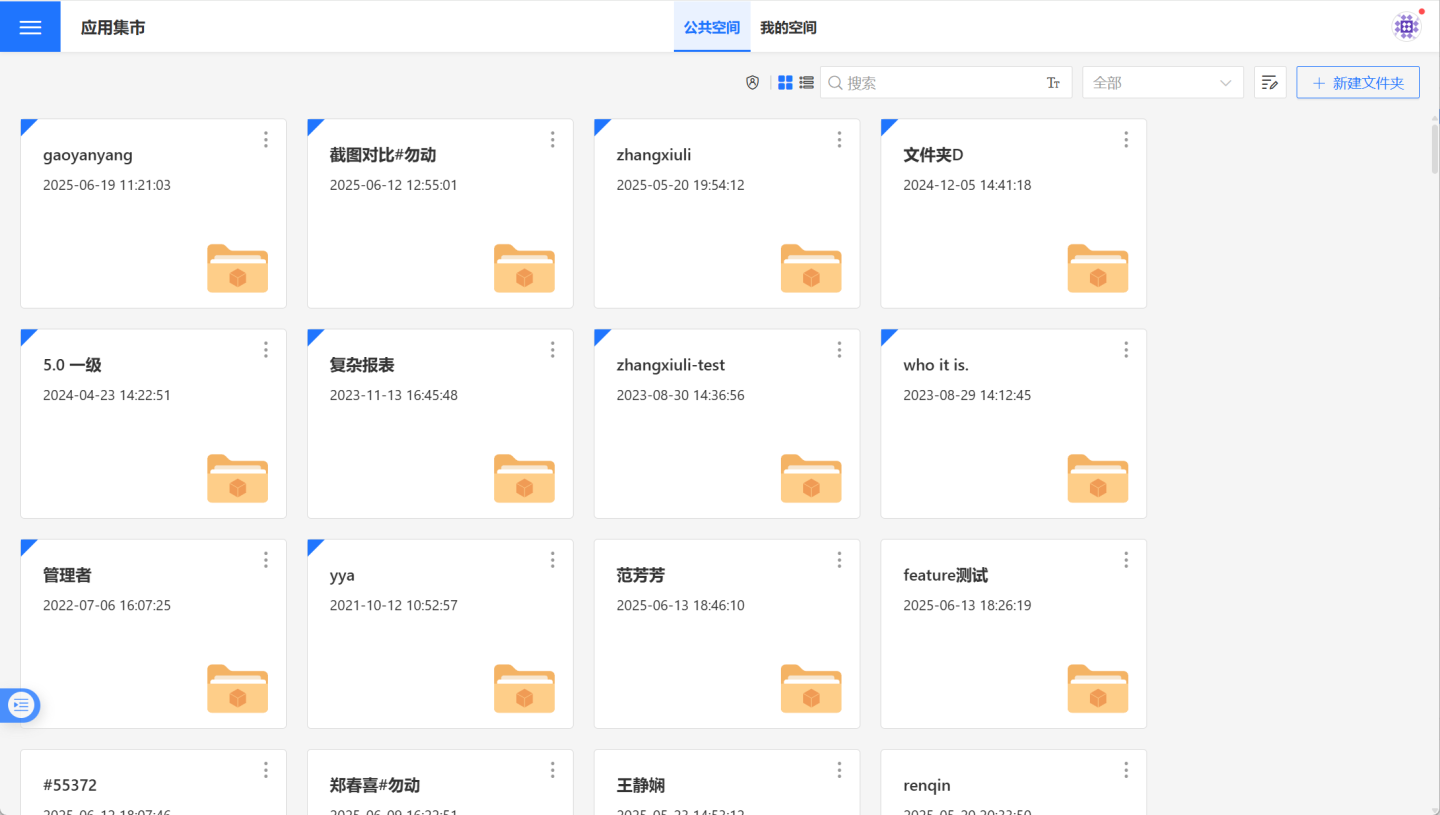
The system supports publishing applications from App Creation -> Team Space/Personal Space to this area for unified management as corporate public assets.
Public Space Administrator
A Public Space Administrator is a user who simultaneously holds the roles of "System Administrator" and "Data Analyst." The administrator is responsible for defining the hierarchical structure of the public space and can grant permissions for certain directories or applications within it to other users or tenants for viewing. Additionally, they can authorize other users with "Manager" or "Editor" permissions to assist in managing specific directories or applications. This ensures that authorized users can legally and properly view and use the directories and applications they have been granted access to.
Regular users can only see the content they are authorized to access, as well as all direct parent directories of the authorized content.
Tenants can only view the directories or applications authorized by the platform and cannot perform any management or editing actions on them. Tenant administrators, however, have the additional "Manager" permission to further delegate permissions within the tenant system.
Tip
Administrators cannot grant permissions for the public space itself, so regular members cannot create new folders in the root directory of the public space. For details on the permissions administrators can grant for folders and applications, please refer to Permission Management.
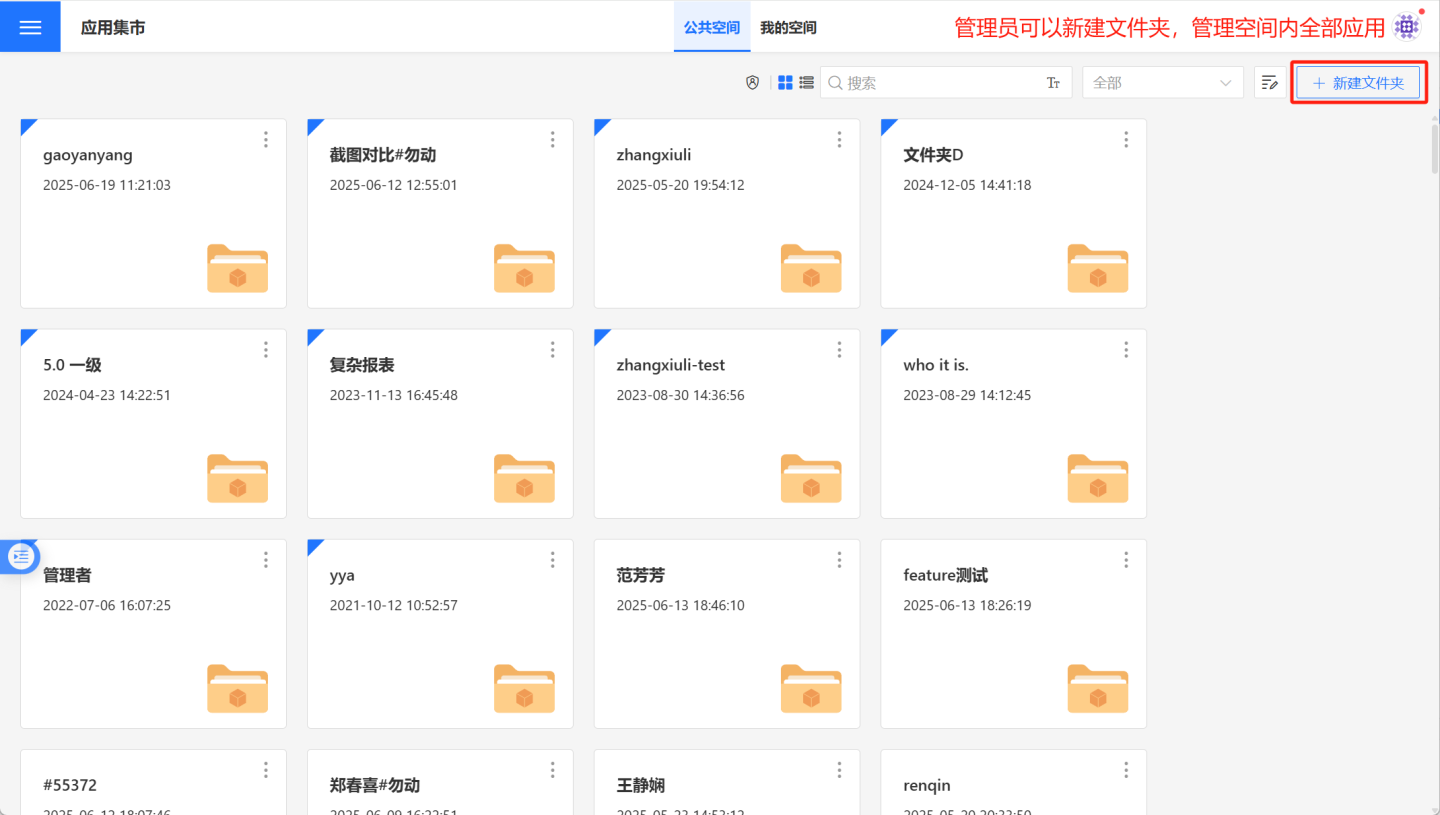
Table of Contents
Permission Management
Public space administrators can manage directory permissions by designating system users as managers, editors, or viewers of the directory. They can also share the directory with tenants. Except for restrictions on exporting to tenant platforms, tenant users and viewers have equivalent permissions. The authorization description can include reasons and details for granting management permissions to users, facilitating future tracking.
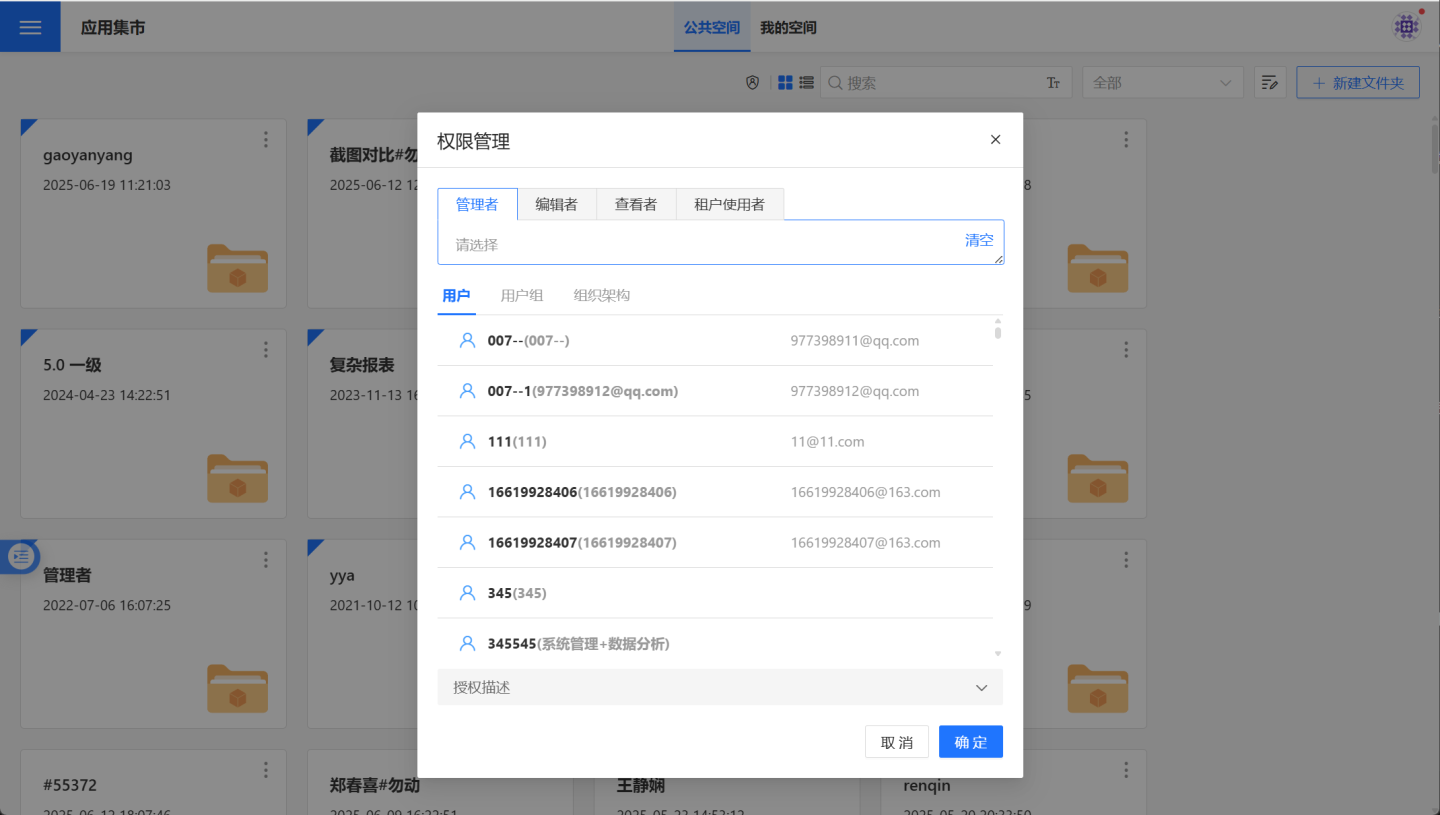
Administrator
Administrators have 'Administrator' permissions for directories they manage, including their subdirectories and applications within each directory, with the same 'Administrator' permissions. Administrators can perform the following operations on the directory, its subdirectories, and applications within directories at all levels:
- Permission Management: Set management permissions for directories, subdirectories, and applications within directories at all levels.
- Settings: Configure applications within directories at all levels, including Basic Settings, Read-Only Interaction Mode Settings, Permission Control, Public Link, and Subscription.
- Create Application Using Template: Create a new application using an existing application as a template.
- Export Template: Export an application as a template.
- Move: Move subdirectories of the current directory and applications within directories at all levels.
- Delete: Delete subdirectories of the current directory and applications within directories at all levels.
- Pin to Top: Pin subdirectories of the current directory and applications within directories at all levels to the top.
Editor
Editors have 'Editor' permissions for the directories they manage, including their subdirectories and all applications within these directories. Editors can perform the following operations on the directory, its subdirectories, and applications at all levels:
- Create applications using templates: Create a new application based on an existing application template.
- Export templates: Export an application as a template.
- Move: Move subdirectories of the current directory and applications within directories at all levels.
- Delete: Delete subdirectories of the current directory and applications within directories at all levels.
- Pin to top: Pin subdirectories of the current directory and applications within directories at all levels to the top.
- Create new folders: Create new folders in the current directory and its subdirectories.
Viewer
Viewers have 'Viewer' permissions for directories and their subdirectories and applications with the same 'Viewer' permissions. Viewers can perform the following operations on the directory, its subdirectories, and applications within directories at all levels:
- Create a new application using a template: Create a new application using the current application as a template.
- Export template: Export the current application as a template.
Tenant Users
The platform grants directory authorization to tenants, allowing tenants to have viewing permissions for the directory, its subdirectories, and applications within. Tenant administrators also have the ability to further delegate permissions within the tenant system.
- Permission Management: Set 'Manager' and 'Viewer' permissions for directories, subdirectories, and applications under each level of the directory. This feature is only available to tenant administrators.
- Create Application Using Template: Create a new application based on an existing application template.
- Export Template: Export an application as a template.
Tip
The 'Manager' of directories shared by the platform in the tenant system only has the functionality of delegating permissions, which is different from the 'Manager' functionality within the platform's system applications.
App
In the App Marketplace, directories and app partitions are displayed at the same spatial level. Directories are shown at the top, while apps are displayed at the bottom.
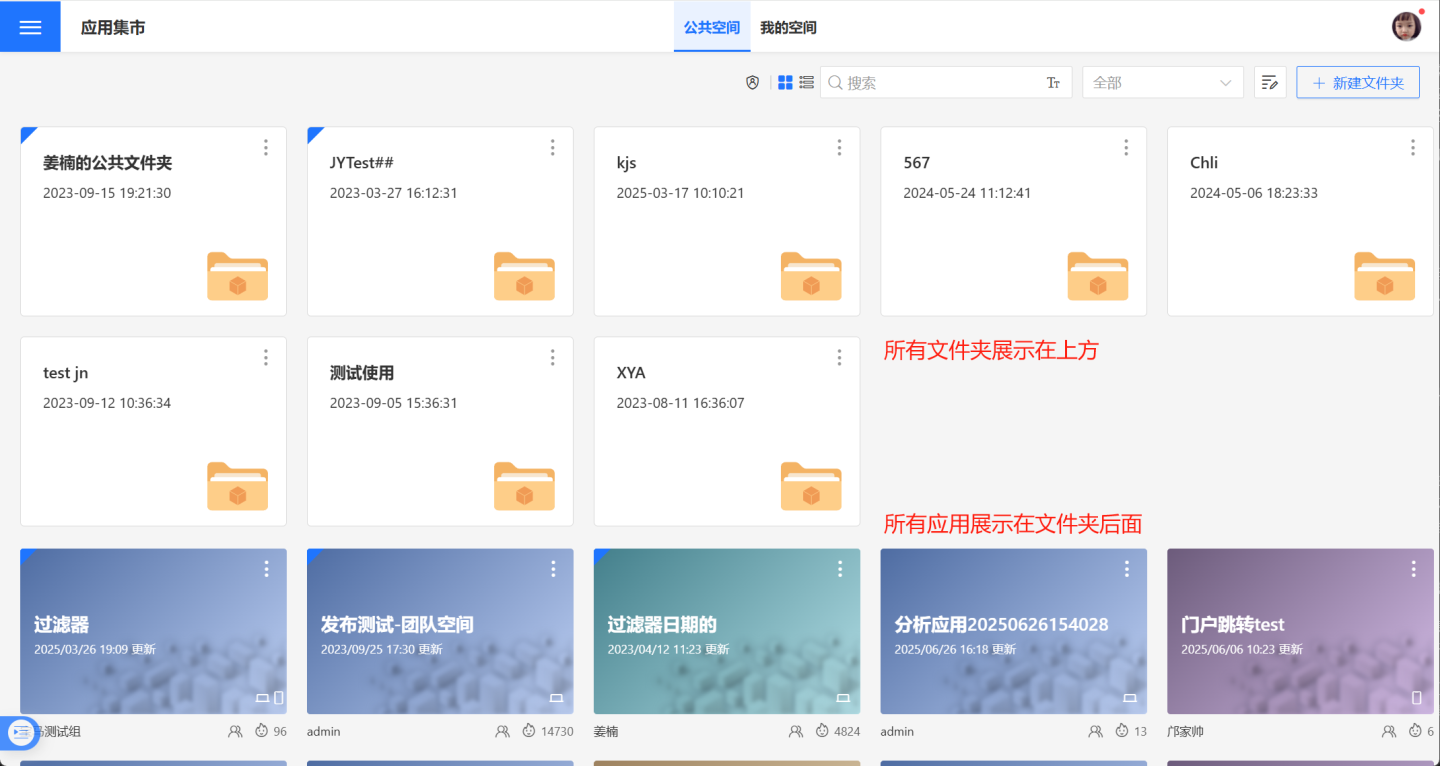
Permission Management
Public space administrators can manage permissions for applications, setting administrators, viewers, and tenant users for the applications.
Administrator
Administrators can perform the following operations on the app:
- Permission Management: Set permissions for the app, including assigning administrators, viewers, and tenant users.
- Settings: Configure the app, including Basic Settings, Read-Only Interaction Mode Settings, Permission Control, Public Link, and Subscription.
- Create App Using Template: Create a new app using this app as a template.
- Export Template: Export this app as a template.
- Move: Move the current app to a specified directory.
- Delete: Delete the current app.
- Pin: Pin the current app.
Tip
When administrators move, delete, or pin an app, they must have administrator or editor permissions for the parent directory of the current app; otherwise, the related operations cannot be performed.
Viewer
Viewers can perform the following operations on the app:
- Create a new app using a template: Create a new app using this app as a template.
- Export template: Export this app as a template.
Tenant Users
The platform authorizes applications to tenants, granting tenants view permissions for the applications. Tenant administrators can also authorize applications to other members within the tenant system.
- Permission Management: Set manager and viewer permissions for applications. This feature is only available to tenant administrators.
- Create Application Using Template: Create a new application based on an existing application template.
- Export Template: Export an application as a template.
Tip
The 'Manager' of applications shared by the platform in the tenant system only has the functionality of permission delegation, which is different from the 'Manager' functionality within the platform's system.
View Sorting
App Market->Public Space supports displaying space content based on user-selected sorting order:
- Name: Sorting supports A-Z, Z-A.
- Recently Edited: Sorting supports time from newest to oldest, time from oldest to newest.
- Publish Time: Sorting supports time from newest to oldest, time from oldest to newest.
- Access Popularity: Sorting supports highest, lowest.
When displaying sorting results, folders and apps are shown separately.
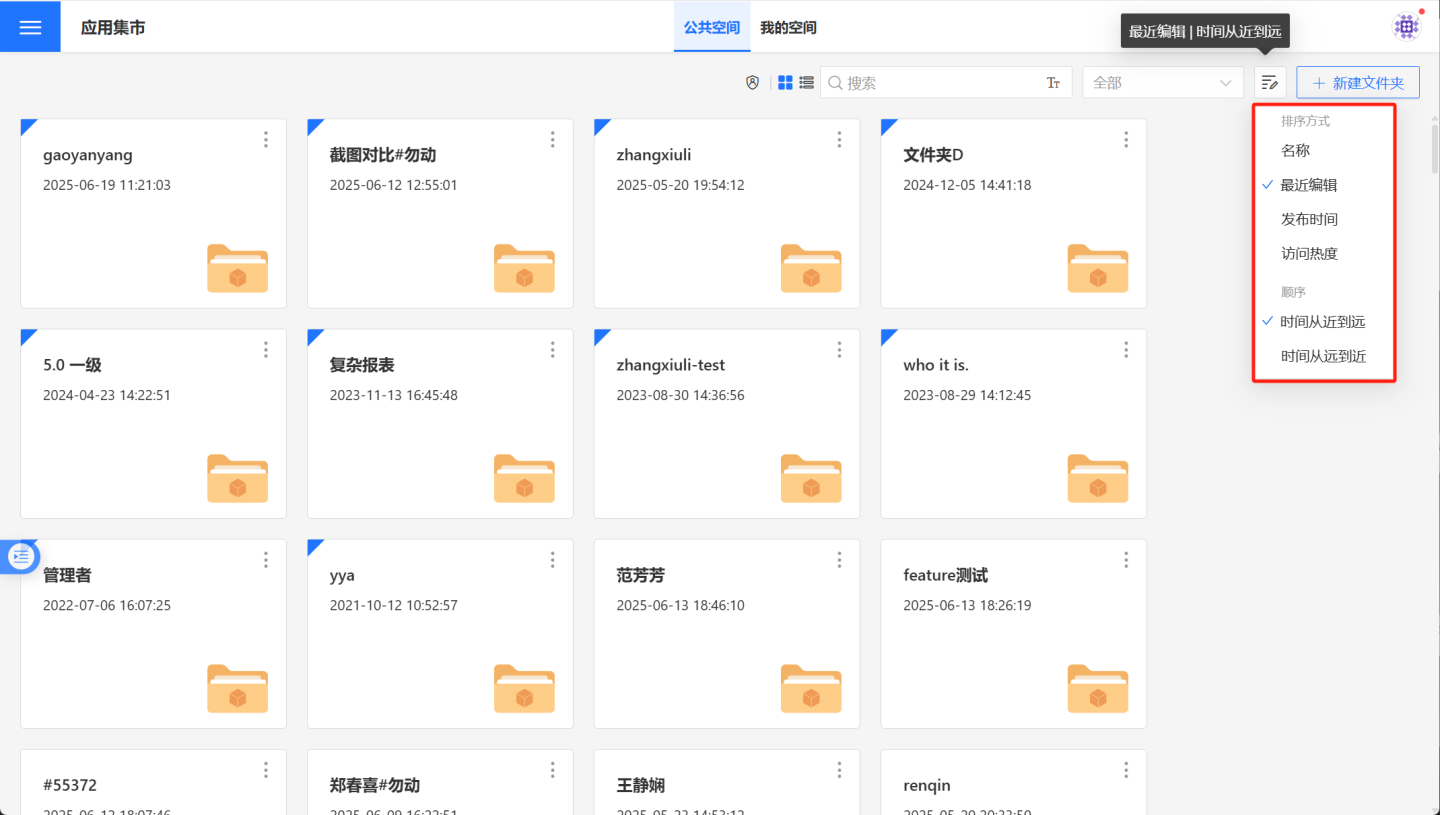
View Filter
App Marketplace -> Public Space supports viewing all data and data authorized to tenants. It also supports filtering by entering directory names or app names.

My Space
Users can publish applications from App Creation -> My Creations to App Marketplace -> My Space. Applications in App Creation -> Team Space cannot be published to this space.
Permissions
There are slight differences between My Space and Public Space:
- My Space is positioned as a personal workspace, maintaining individual resources for a specific user. Therefore, applications only support granting other users the 'Viewer' permission.
- Applications maintained in 'My Space' cannot be authorized to tenants, preventing enterprises from losing complete control over resources authorized to tenants.
- The owner of an application in 'My Space' naturally possesses the 'Administrator' permission, which cannot be revoked and cannot be granted to other users with the same level of permission.
Permission Management
The owner of an app is inherently the 'administrator' of the app and can manage permissions, designating system users as viewers of the app. Apps in My Space are considered personal assets and no longer support authorization to tenants.
Viewer
Viewers can perform the following operations on applications in App Marketplace -> My Space:
- Create an app using a template
- Export a template
- Hide/Show
- View the app

View Sorting
App Market -> My Space supports displaying space content based on the user's preferred sorting order:
- Name: Sorting supports A-Z, Z-A.
- Recently Edited: Sorting supports time from newest to oldest, time from oldest to newest.
- Publish Time: Sorting supports time from newest to oldest, time from oldest to newest.
- Access Popularity: Sorting supports highest to lowest, lowest to highest.
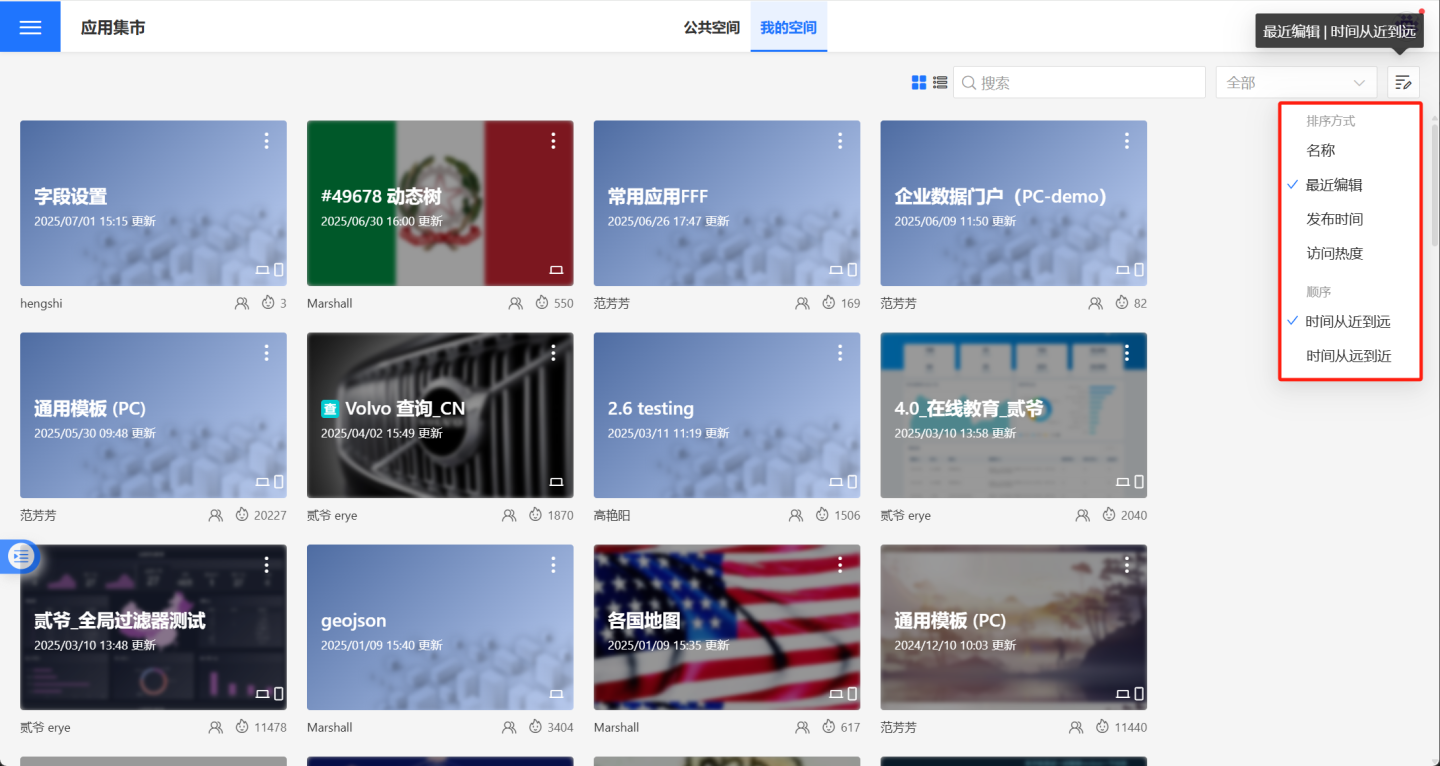
View Filters
When there are too many published apps, you can filter and search based on your needs. The system provides a search box for searching and a dropdown list for filtering. The dropdown list categories include: All, Published to Me, My Published, My Hidden.

Search Box
Enter keywords in the search box to search for apps whose names contain the specified keywords.
The search box can be used in combination with dropdown list filters. For example, search for apps published to me whose names contain "Portal":
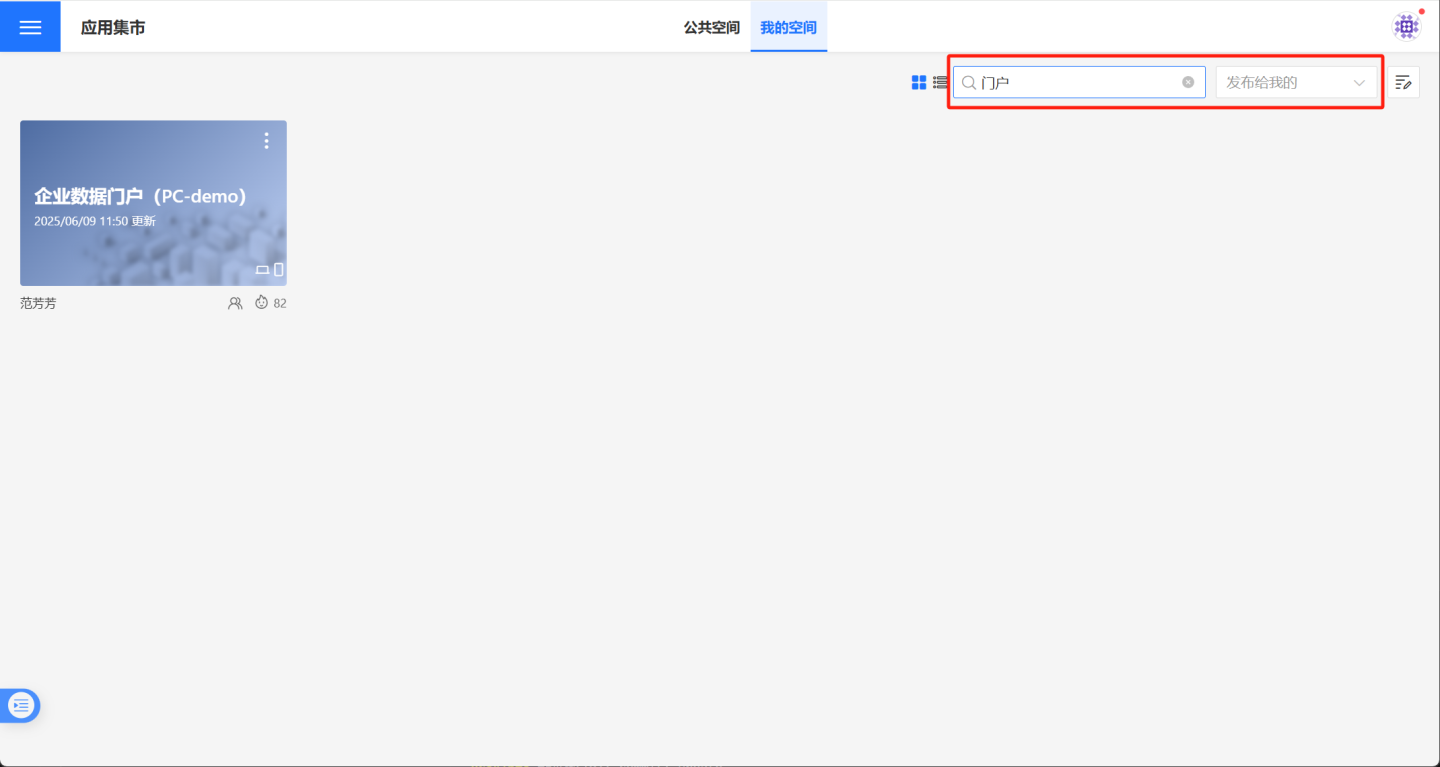
All
The All category lists all published apps that the current user has permission to view, including My Published, Shared with Me, and Hidden by Me apps.
In the All category, for apps shared with me by other users, the app menu does not include the Hide button.
If other users selected the Export App Template option when publishing an app, the app menu in the All category will include the options: Create App Using Template and Export Template.

Published to Me
The Published to Me category only includes apps where the current user has been selected as a Viewer in Permission Management.
Only when the current user's role includes Data Viewing, can other users select this user during the Permission Management setup process.
If the user's role only includes Data Analysis, other users cannot designate them as a target for permission control. Therefore, there are no apps under the current category in this case.
In the Published to Me category, the current user can only hide apps but cannot delete them.

My Published
The My Published category contains all the applications published by the current user.
The current user can perform the following operations on the applications:
Edit
Permission Management
Dashboard Blacklist
Settings
Create Application Using Template
Export Template
Hide
Move To
Delete

My Hidden
Users can hide applications published by others as well as those they have published themselves. All applications hidden by the current user will be listed under the My Hidden category.
Under the My Hidden category, users can make hidden applications visible again.
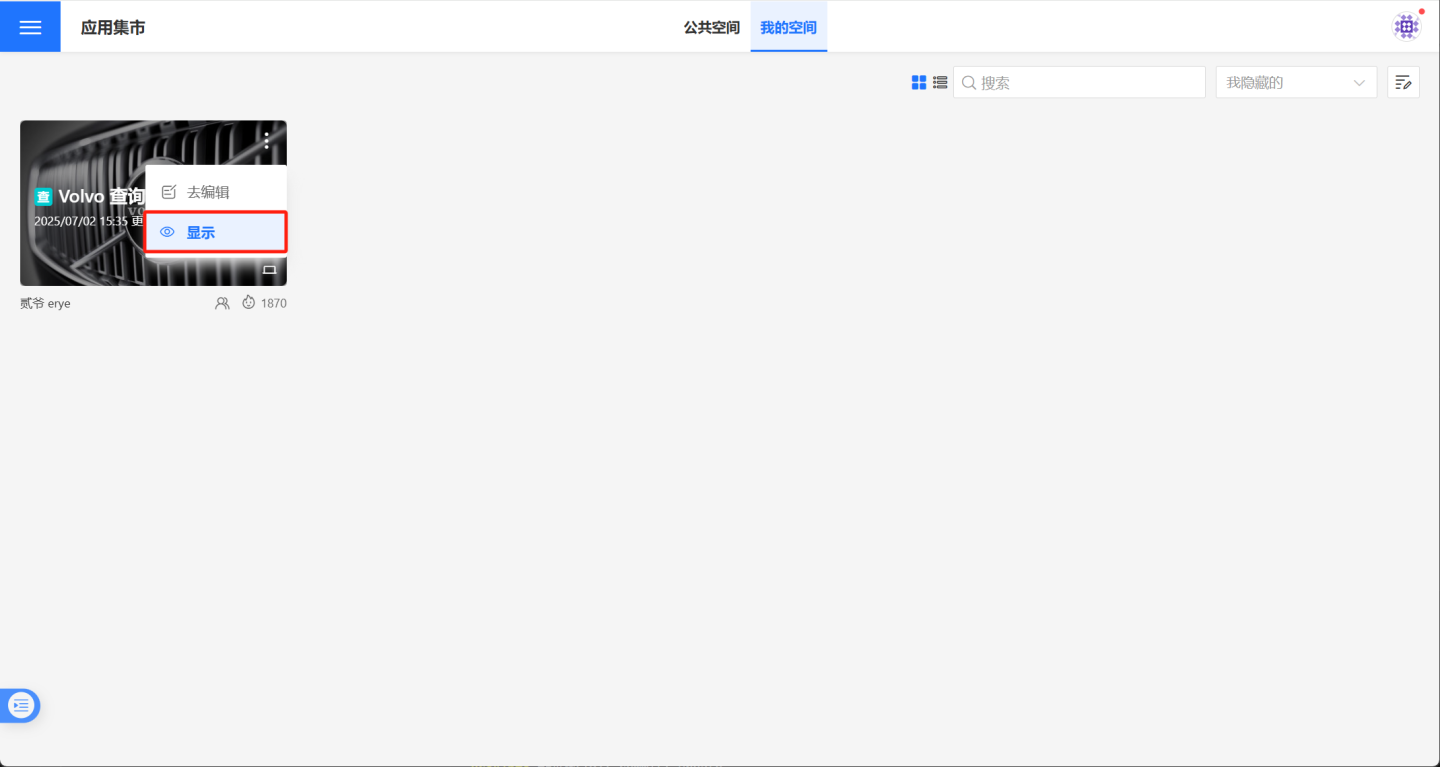
Tip
The system will remember the last selection. After performing other operations and returning to the App Marketplace page, the page will retain the type selected last time.
Operations
Go to Edit
When an app in the App Marketplace needs to be updated or modified, users must return to the app creation section to locate the original app for editing, which involves a relatively long operation path. The "Go to Edit" button allows users to quickly jump to the editing mode of the app, making the operation convenient and efficient.
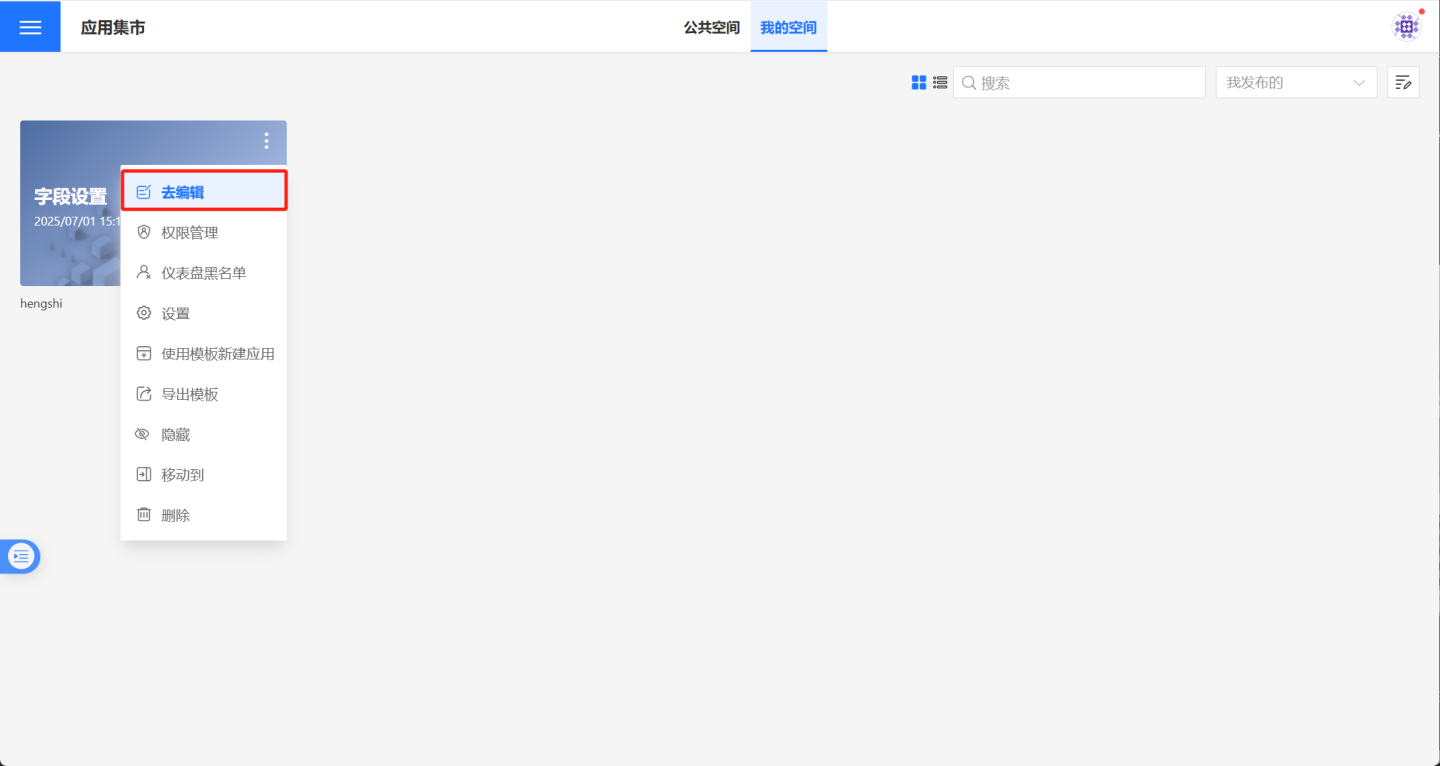
Tip
The "Go to Edit" feature is controlled by the app editing permissions in the creation area. Users without editing permissions in the creation area will see a "Permission Denied" message when clicking the "Go to Edit" button. Apps authorized by the platform to tenants do not have this option. Users with only the data viewer role will not see this option for apps in the App Marketplace.
Settings
Administrators of the app can configure the app via App Marketplace > App > Settings.
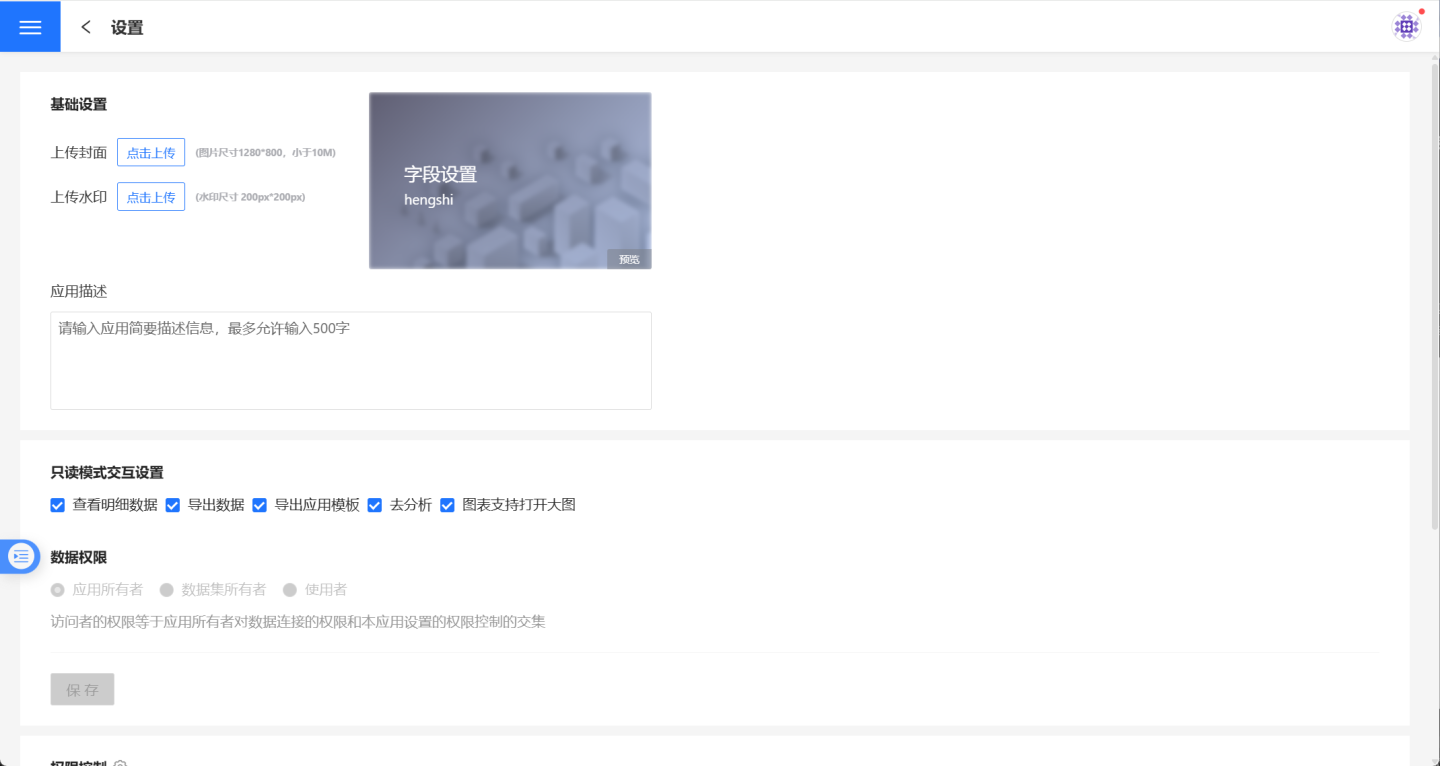
The specific configuration content is consistent with Application Publishing when published.
Go Analyze
The Go Analyze feature needs to be manually enabled. Once enabled, a Go Analyze button will appear in the menu at the top right corner of the chart. Clicking it will redirect you to the analysis page.
Create a New App Using a Template
As long as the app creator selects the Export App Template option during publishing, other users can create a new app using this app as a template in the App Marketplace.
Click the menu button in the upper-right corner of the app, then click Create a New App Using Template. The system will prompt "Creation successful, you can view the app in App Creation." A new app will be created in the user's App Creation area using this app as a template.
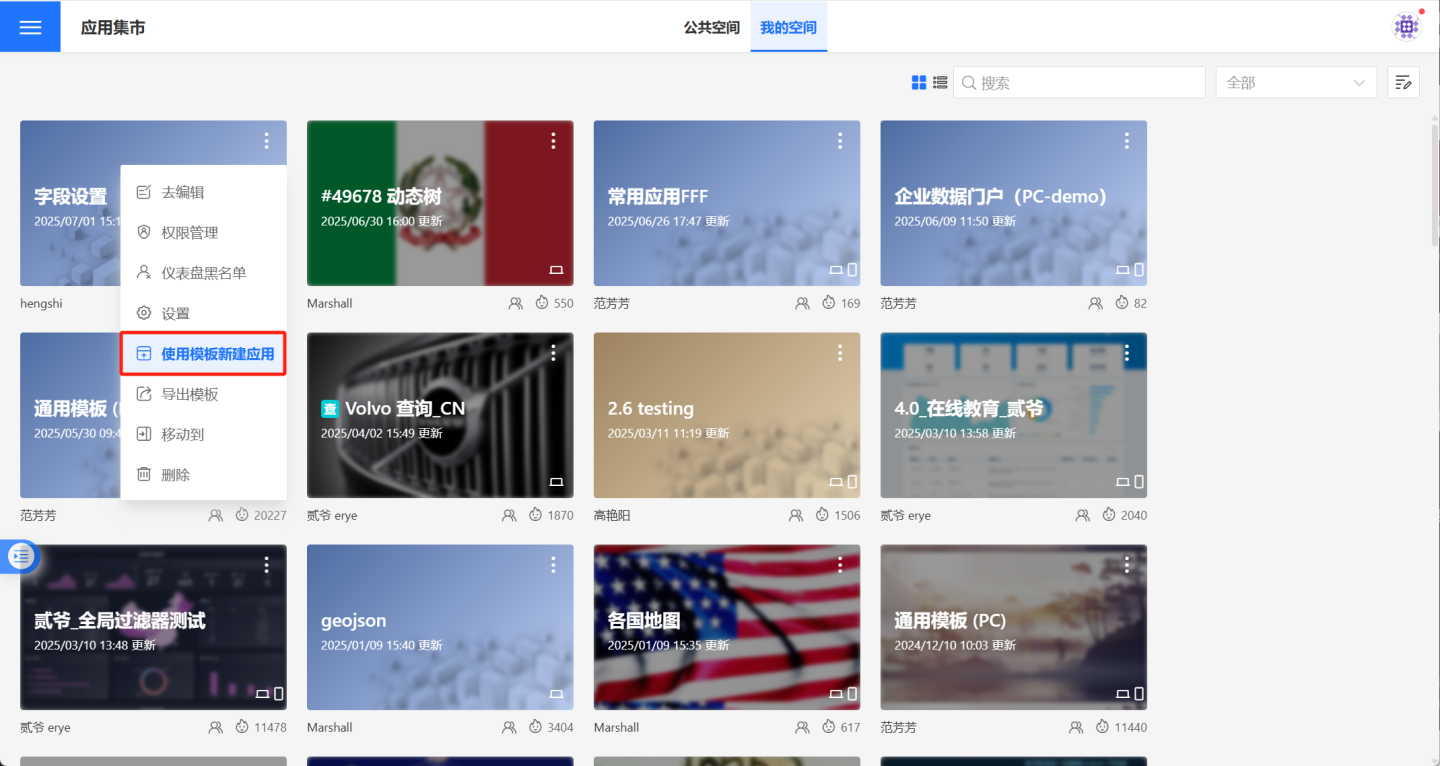
Export Template
As long as the application creator selects the Export Application Template option during publishing, other users can export the template in the App Marketplace. Tenants are not allowed to export application templates.
Click the menu button in the upper-right corner of the application, then click Export Template to export an application template file in hstpl format.
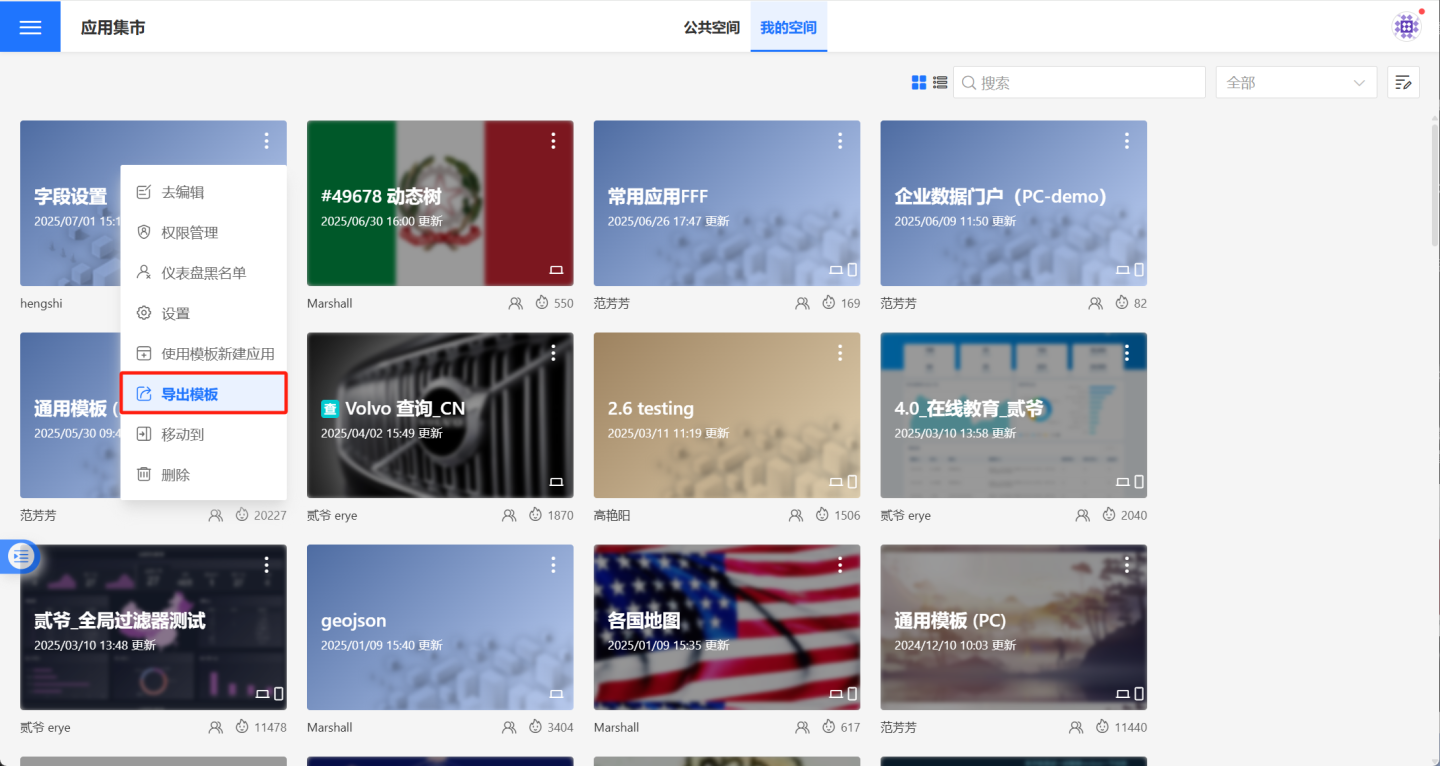
Move
Users with 'Administrator'/'Editor' permissions for an app can perform the 'Move' operation.
- Supports moving apps between the 'Public Space' and 'My Space' in the App Marketplace;
- Supports 'Retain Permissions' during the move:
- Retained permissions refer to manually granted permissions for the app, excluding permissions inherited from the directory;
- When moving an app from 'Public Space' to 'My Space', retaining permissions is not supported;
- If the mover does not have administrator permissions for the target directory, permission settings cannot be retained.
- Apps published from
App Creation->Team Spacecan only be moved within the Public Space and cannot be moved to 'My Space', adhering to the principle of centralized resource management in the Public Space; - Apps published from
App Creation->Personal Spacecan only be moved by the owner from 'My Space' in the App Marketplace to 'Public Space', and can also be moved back. When moving back, retaining permissions is not supported.
Moving apps in Public Space

Moving apps in My Space

Delete
In App Market -> Public Space, you can delete apps for which you have 'Administrator'/'Editor' permissions. In My Space, you can delete apps under 'My Published'. Click the '…' menu button of the app and then click Delete to remove the app.
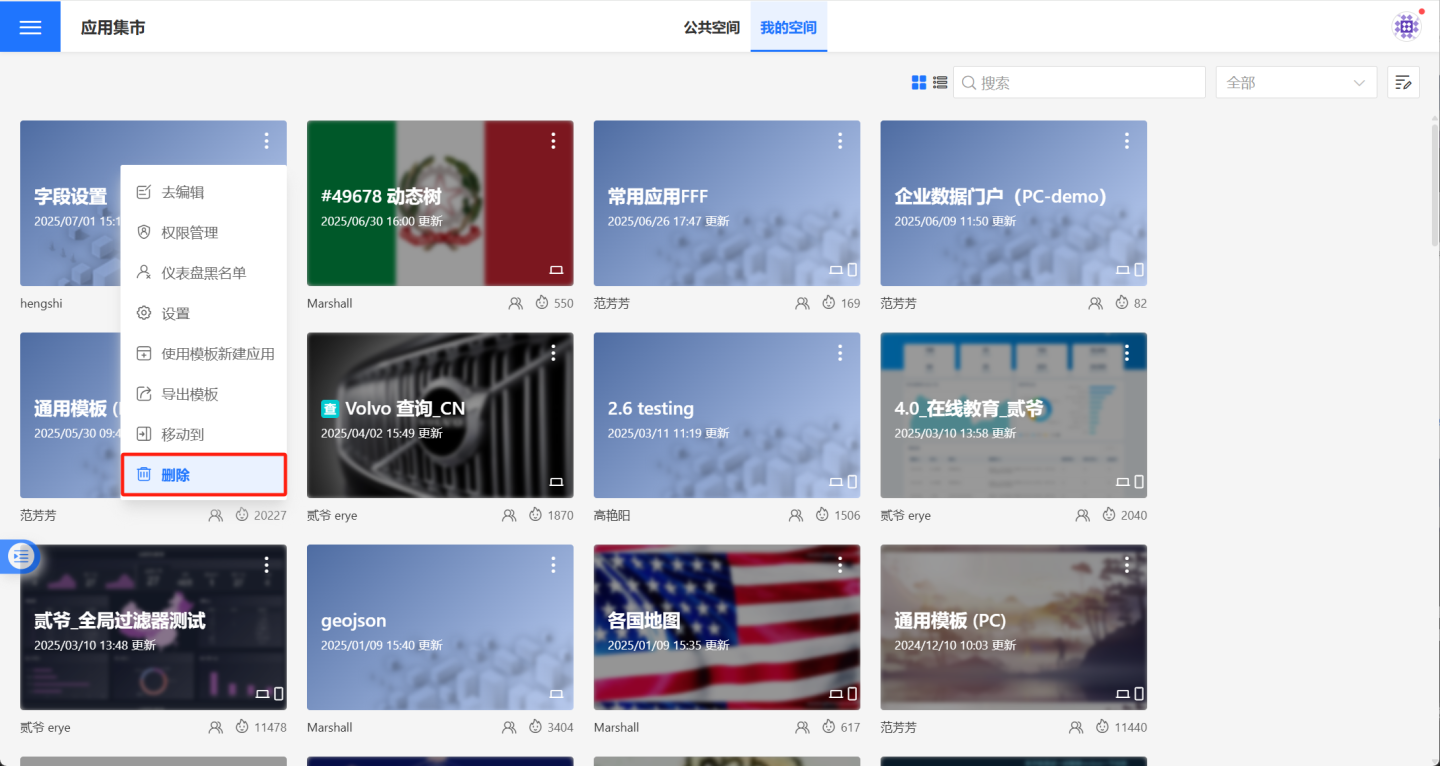
After deleting an app in the App Market, the "Published" icon will no longer appear on the cover of the app in App Creation.
Hide
You can hide applications published by other users in the Published to Me category.
Click the three-dot menu in the upper right corner of the application and select Hide to enable the application hiding feature.
Display
You can display the apps you have hidden in the Hidden by Me category.
Click the three-dot menu in the upper-right corner of the app, then click Display to make the hidden app visible.
Space Naming and Display
My Space and Public Space support name modification and adjustment of the display order. These settings can be configured in App Market Management.
Tip
- All users can access the app through the Public Link in the Publish Settings.
- The current user can only hide, but not delete, apps published by other users in the Shared with Me category.
- Users with the "Data Scientist" role can delete apps they have published in the All, My Published, and My Hidden categories.